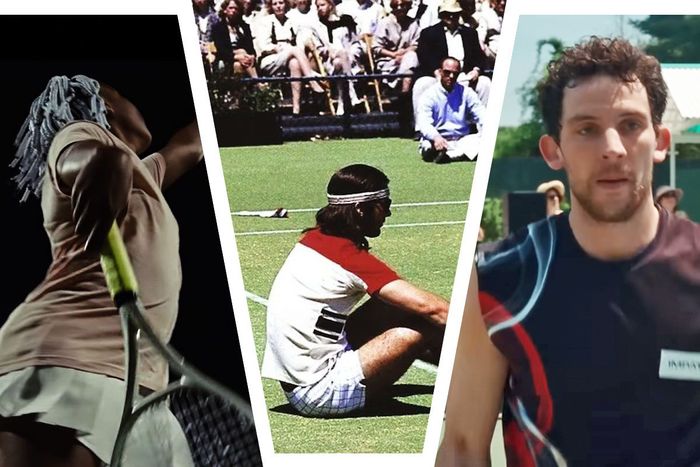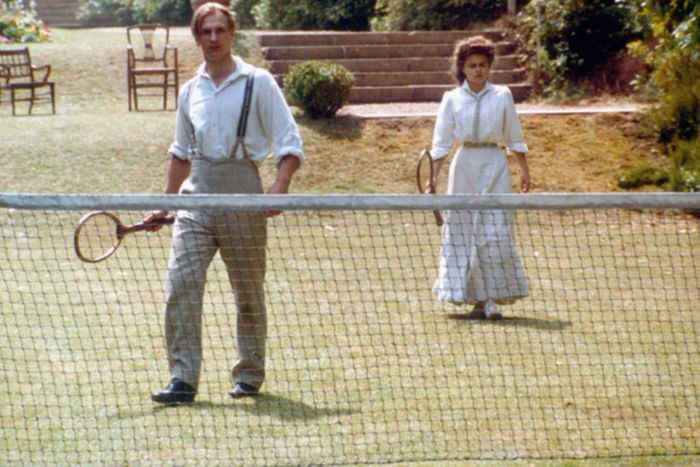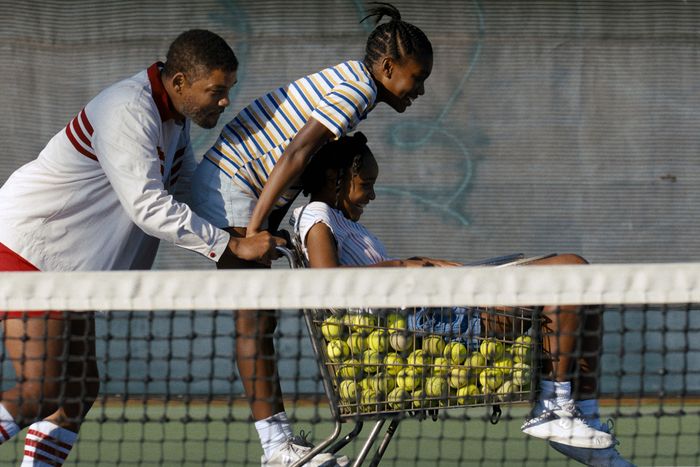
This article was published August 26, 2022. We’ve updated it to include one hell of a match from the new movie Challengers.
Tennis is a sport of personal intensity and triumph. Granted, there are ways to play tennis in teams, from doubles to Billie Jean King’s long-standing dream of making World Team Tennis one of our major sports. But at its core, tennis is about individuals, which is why it lends itself surprisingly well to the movies.
There’s a misperception, however, that tennis isn’t a good movie sport because there haven’t been that many great tennis movies. King Richard — overshadowed as its legacy is post-Slap — is one of the rare examples of a movie that forefronts the game in the same way a baseball movie like The Natural or Field of Dreams or a football movie like Rudy or The Longest Yard revolves around their respective sports. But to disregard cinematic tennis for this reason would be to underestimate its power as a game particularly well-suited for scenes. It’s the tennis scene we should be talking about.
Tennis scenes can crop up everywhere from broad comedies to sinister thrillers, and they tell us a lot about the characters involved and their relationships to one another: Are they selfish with a racquet? Reckless? Confident? Is one player letting the other win, hinting at a yet-to-be-fully explored attraction? Or is the competition cutthroat, representative of an otherwise stifled tension felt by one or both sides? The stop-and-start nature of the activity means these characters can still deliver rapid-fire dialogue in between shots, but it’s the body language that speaks volumes. Plus, unlike sports that require loads of equipment, facilities, or experience, any two people can play tennis at a public park, a recreational center, or someone’s Beverly Hills backyard if they’re so fortunate. Tennis scenes are therefore convenient, relatable, and character-building: screenwriting gold.
Occasionally, great tennis scenes give good tennis form, too. It’s not crucial, but in ranking the best of the tennis scenes committed to film, the quality comes in helpful for tiebreakers. With apologies to runners-up Bachelor Party (featuring Tom Hanks sending balls soaring out of the court like he’s Ted Williams), Borg vs. McEnroe (with Shia LaBeouf as tennis’s premier brat John McEnroe), Clueless (where it’s inadvisable to send objects flying at a new nose), Bee Movie (in which animated honeybee Jerry Seinfeld endures a particularly harrowing experience on the court), and The Power of the Dog (featuring Thomasin McKenzie as cinema’s chirpiest chair umpire), here are the 13 best examples of the microgenre.
13. Annie Hall (1977)
12. Match Point (2005)
Woody Allen’s presence on this list is inevitable. He has two movies where tennis shows up most prominently and strategically: in one as a drop-shot-delicate character device and in another as a great big overhead smash of a thematic metaphor. In Annie Hall, Allen’s Oscar-winning romantic comedy, the big meet-cute between Diane Keaton’s title character and Allen’s Alvy Singer happens after playing mixed doubles with their friends. The film breezes past the tennis to get to the “la di da” of Annie and Alvy’s verbal volleying, but from what we do see, Annie’s game appears to be as flighty and unfocused as her personality: She’s swinging wildly, she’s not planting her feet, she’s not even watching where her ball goes and is thus unprepared for the return. For such a brief scene, it’s Annie in a nutshell; all her heedlessness is why she was never going to gel with neurotic Alvy.
Fast-forward 28 years to Allen’s Match Point, a sinister drama about a tennis pro (Jonathan Rhys Meyers) looking to swing his way into London high society, and when an American woman (Scarlett Johansson) tempts him into a precarious position, he’s willing to commit murder to retain his standing. The metaphor comes nice and early, with Meyers in voice-over talking about the role that luck can play in a man’s fortunes. With the camera fixed on a tennis net, we see a ball hit the net cord and fly straight up into the air. Where it falls is up to chance, yet its eventual position will decide the outcome of a match and thus the future of the players involved. It foreshadows the moment when an incriminating piece of evidence clips a railing instead of being discarded into the river. As a tennis scene, it’s not exactly a traditional one; you can’t even see either of the players. But it showcases the sport as an appropriately bourgeois vessel for a story about social climbing and a “win at all costs” mentality. Call it cinema’s most portentous let.
11. 7 Days in Hell (2015)
Inspired by the 2010 first-round Wimbledon match between John Isner and Nicolas Mahut that lasted over 11 hours, played across three days, and ended at 70-68 in the fifth set, the HBO mockumentary 7 Days in Hell imagines something even bigger: a seven-day marathon match that refused to end, long after it descended into misery, ultimately (spoiler!) ending with the fictional Aaron Williams (Andy Samberg) and Charles Poole (Kit Harington) killing each other in the middle of the court. Picking just one moment to represent the film is a challenge, but the cocaine scene holds particular interest for tennis fans. Down one set after the first day, Williams roars back to take the next two, though his burst of energy is dubious. As we learn from talking-head Serena Williams, Aaron (her “reverse Blind Side” adopted brother) had surreptitiously hidden cocaine all over the court — in his water bottle, in his racquet, even on the lines on the court — and we see him very obviously snorting throughout the second day. Samberg’s Williams was already sporting a 1990s Andre Agassi wig at this point, a sharp jab at the player’s later-revealed substance use during his bad-boy years.
10. A Room With a View (1985)
Tennis has often been used as cinematic shorthand for a leisure activity among the well-to-do, and A Room with a View showcases this better than most. One of the great Merchant Ivory costume dramas of the 1980s, A Room With a View begins with a vacation in Italy, where Lucy Honeychurch (Helena Bonham Carter) meets and shares a fleeting but rather swoony hillside kiss with George Emerson (Julian Sands). Back in England, Lucy gets engaged to the more suitable Cecil, though George shows up again as a friend of Lucy’s brother. It’s all pretty dishy, no more so than the scene where a tennis match serves as the backdrop for Lucy and George’s furtive glances. As Cecil (Daniel Day-Lewis) reads aloud from a flowery and, in Cecil’s estimation, poorly written novel, Lucy and George engage in some mixed doubles with Freddy and another friend. As Cecil reads on, Lucy and George realize that the novel is borrowing heavily from their brief Italian encounter. The tennis itself is more hobby than sport in this scene, but it gives Merchant and Ivory a great opportunity to contrast the athletic, exuberant George (who twice takes a running leap over the net) with the prissy, hypercritical Cecil. The choice for Lucy, as we in the audience are fully aware, is an easy one.
9. Wimbledon (2004)
Richard Loncraine’s Wimbledon is the ultimate “if you know, you know” movie. General audiences will see in it a pretty standard sports-movie/rom-com hybrid where Paul Bettany’s veteran tennis player falls in love with Kirsten Dunst while chasing down a miracle championship at the titular English tournament. But tennis fans, especially if they were watching in the ’90s and early aughts, will immediately clock Bettany’s Peter Colt as a stand-in for Tim Henman, the top-ten player who for years was the fervent hope of British tennis fans to finally have a British champion at Wimbledon for the first time since 1936. In real life, Henman repeatedly topped out at the semifinals stage (though he delivered no end of thrilling matches along the way), but onscreen, the Brit wins the big one.
The movie’s big scene sees Colt three points from the match, battling his nervous inner monologue as much as his opponent across the net. The scene packs a lot of tennis intrigue into a few short minutes, from a dubious line call (the chalk flew up!), to some exciting serve-and-volley play, to Colt’s opponent (Austin Nichols) hitting a between-the-legs shot down match point. Colt finally hits a diving volley to take the match and the championship, with Dunst cheering him from the stands. Loncraine was actually able to film some scenes at the prestigious All England Tennis Club during its 2003 tournament (where Henman lost in the quarterfinals to French journeyman Sébastian Grosjean), something that contributed a good bit of grandeur to the film, enough to counterbalance the distracting CGI tennis ball being batted around in scene after scene.
8. Battle of the Sexes (2017)
The titular televised match between Billie Jean King and Bobby Riggs is one of sports’ best-remembered blowouts. King’s straight-sets triumph over the braggadocious chauvinist wasn’t much in doubt once the players were on the court, though there was plenty of speculation leading up to the match. Directors Jonathan Dayton and Valerie Faris chose to film the match scenes from a high angle to mimic the effect of watching on TV. And while that means we’re not up close and personal with Emma Stone and Steve Carell as they battle their way through, their stunt performers, Kaitlyn Christian and Vince Spadea, deliver one of the more true-to-life depictions of real tennis on film. That distance also allows Dayton and Faris to depict the match as a spectators’ story. The film’s best tennis scene comes at match point, with the crowd holding its collective breath; Billie Jean returns Bobby’s serve and runs him all over the court, and when she finally hits the ball past him, she tosses her racquet up in the air in an exuberant but by no means disbelieving celebration. To Billie Jean King, the outcome of the match was never in doubt. But to those in attendance at the Astrodome and those watching from home, they had to see it to believe it.
7. King Richard (2021)
King Richard is a film about Richard Williams and his grand plan to raise the two most dominant tennis players of all time, but its best tennis scene is all Venus Williams (Saniyya Sidney). At the climactic match at the Bank of the West Classic, only Venus’s second professional match, she takes the court against world No. 1 Arantxa Sanchez Vicario. Director Reinaldo Marcus Green keeps his camera low to emphasize the vastness of the tennis world bearing down on Venus, all while Richard (Will Smith) watches on, ever enigmatically, from the tunnels. This, along with the aforementioned Wimbledon scene, is maybe the most traditional Sports Movie depiction of a tennis match on film, as everything the film has built up to in the story of Richard and Venus Williams is now riding on the outcome of this one big match. Green pulls off a nifty but necessary trick here, convincing an audience who already knows the dizzying heights of success that Venus will reach to be on tenterhooks over the outcome of this one match. When Sanchez Vicario, ever the wily veteran, takes an extended bathroom break just as Venus has her on the ropes, the audience is up in arms. We see what Venus is up against. Ultimately, Green delivers the classic Sports Movie ending, a Rocky-approved silver lining on the agony of defeat and the promise of greatness to come.
6. The Royal Tenenbaums (2001)
Each of the Tenenbaum kids has their moment of squandered potential, and for Richie (Luke Wilson), the former tennis prodigy with the McEnroe headband, it was his promising tennis career hitting the skids in a televised on-court breakdown at “Windswept Fields.” For everything else that’s notable about The Royal Tenenbaums, it’s also Wes Anderson’s New York movie, and one of its many pleasures is the little niches and corners of the city that appeal to Anderson’s sensibility. And there is no more Wes Anderson–y corner of New York than the West Side Tennis Club at Forest Hills, the former site of the U.S. Open, with its grass lawns and Tudor-style clubhouse overlooking the courts. The sight of Richie, distraught over his sister’s marriage to Raleigh St. Clair, sitting on the baseline, shoes off, about to drop a triple-bagel to his opponent (named Gandhi, sure), all while unseen commentators voiced by Jason Schwartzman and Andrew Wilson deadpan their astonishment, is the film’s most stark depiction of rock bottom.
5. Bridesmaids (2011)
The only tennis scene in film temperamentally fit for an AC/DC montage, Bridesmaids’ showdown between Annie (Kristen Wiig) and Helen (Rose Byrne) is a grudge match for the ages. While the tennis itself only lasts a minute of screen time, the passive-aggressive buildup over whether people (i.e., their shared friend Lillian) actually change makes the competition feel endless. On court, Annie and Helen spray their shots with unrestrained ferocity, aiming not for the baselines but for each other’s torsos. Director Paul Feig opts for slo-mo impact shots that would be the envy of the most stylish action director, as Saturday Night Live alums Melanie Hutsell (“Get your shit together, Carol!”) and Nancy Carell end up being not so much doubles partners as bewildered spectators.
4. Strangers on a Train (1951)
It’s no surprise that cinema’s great master of suspense would deliver one of the most thrilling tennis matches onscreen. As Alfred Hitchcock’s tale of murder and depravity builds to its climax, the film’s ostensible hero, tennis professional Guy Haines (Farley Granger), needs to get out ahead of the psychopath (Robert Walker) who means to frame him for a murder. But before he does, Guy needs to win his big match at Forest Hills and then slip the tail of the police detective who’s been keeping tabs on him. As the announcer remarks upon how the normally meticulous and unflappable Haines is playing with an uncommon aggression, Hitchcock’s urgent camerawork and rapid cuts show Guy, pressed for time and needing to make a hasty exit, playing at a pace that would give Rafael Nadal an aneurysm. Honestly, the Haines-Reynolds match looks like a barn burner, full of intensity and changes in momentum that would’ve been pretty thrilling to watch even without knowing that at the same time, a madman dropped the cigarette case he planned to frame a man with down a sewer grate.
3. The Squid and the Whale (2005)
Noah Baumbach’s painfully incisive portrait of a family divorce among a remarkably prickly family of Brooklyn intellectuals finds so many ways to showcase its characters’ most brittle sides. And since few activities are better at exposing the cracks within a bougie family unit than tennis, Baumbach opens his film with an intrafamilial game of mixed doubles. Within minutes, Jeff Daniels’s Bernard is making dubious line calls and instructing his oldest son, Walt (Jesse Eisenberg), to attack his mother Joan’s backhand, while she (Laura Linney) nags at Bernard not to curse and at Walt not to gloat. The microcosm of this family unit in its death throes is all there right on the court, from Bernard’s toxic competitiveness to the way Walt unconsciously picks up on his dad’s cues and then lords his victory over his little brother (Owen Kline).
2. Challengers (2024)
We’re showing incredible restraint by not immediately rocketing Challengers to No. 1 on this list, but to protect against recency bias, we’re putting it discreetly at No. 2. The scene in question is the emotional and athletic climax of the film, as the third set between multi-time Grand Slam champion Art Donaldson (Mike Faist) and his former best friend turned rival Patrick Zweig (Josh O’Connor) hurtles toward a tiebreak. With Art’s wife and coach, Tashi (Zendaya) — who also happens to be Patrick’s ex — looking on from the bleachers, the whole complicated web of attraction and betrayal that exists between the three of them plays out on the court. The scene crescendoes into an insane point where both men end up locked in a nonsensical volley exchange that goes on for way too long, until one hellacious overhead smash ends the point and lights a match to the sexual tension that’s been wafting across the court the whole game. The scene, like the film itself, is sexy and intense, with the momentum liable to turn in an instant — just like the best tennis matches in real life.
1. Blow-Up (1966)
Baumbach showed us how the tennis match could function as a perfect opening to a movie, but 40 years prior, the great Italian master Michelangelo Antonioni used a tennis match as his closing scene and pulled it off so well that film scholars are still talking about it. Antonioni’s landmark movie is about a photographer, played by David Hemmings, who believes he’s unwittingly snapped proof of a murder while surreptitiously taking photos of a pair of lovers in a park. The film explores all sorts of themes of perspective (whether we’ve actually seen what we think we’ve seen; whether we can even believe the images presented to us on film) through the point when Hemmings’s character comes upon a troupe of mimes who’ve taken to a tennis court to stage an imaginary match. As a pair of them bat the “ball” back and forth — exhibiting graceful form, even if their ground strokes don’t seem all that formidable — Antonioni’s camera begins to follow the action more intently, until the “ball” is hit over the fence, and Hemmings must make the decision to indulge in this act of surreality and throw it back onto the court. As the camera fixes on Hemmings’s face, suddenly the sounds of real racquet strikes and a bouncing ball can be heard. Are we feeling what Hemmings is seeing? Is Hemmings existing in reality at all? Or has Antonioni revealed his whole film to be an abstraction? It’s probably the most highbrow tennis match in cinema history, and it may not have ever happened.




